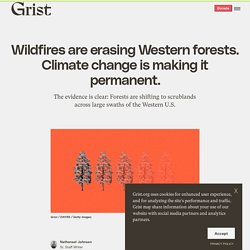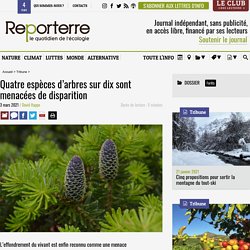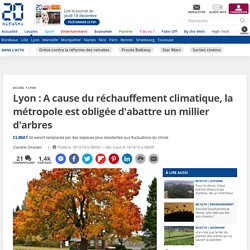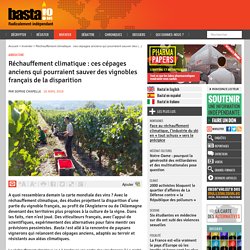

29 nov. 2021 Wildfires are erasing Western forests. Climate change is making it permanent. The trees were not coming back.

In the years following the 2000 Walker Ranch Fire, Tom Veblen, a forest ecologist at the nearby University of Colorado, Boulder, saw that grass and shrubs were regrowing in the charred foothills, but he had to search to find the rare baby version of the tall ponderosa pines that had dominated the area before the fire. “I kept watching and I was barely seeing any seedlings at all,” Veblen said. One of his graduate students at the time, Monica Rother, who now leads her own lab at the University of North Carolina at Wilmington, took a closer look, formally sectioning off research plots and returning year after year to count little trees. 3 mars 2021 Quatre espèces d’arbres sur dix sont menacées de disparition. David Happe est technicien forestier et ingénieur écologue.

Il s’investit dans l’étude de la biodiversité et la gestion des arbres depuis près de trente ans. 16 nov. 2020 Maïdo : l'incendie de trop à la Réunion. La colère est immense.

Au Parc National de La Réunion et dans la communauté écologue de l'île, la colère s'ajoute à la tristesse et à la crainte. Les scientifiques et les défenseurs de l'écologie insulaire s'inquiètent de la perte de biodiversité après de nouveaux incendies, dans l'ouest réunionnais. LE GÉNIE DES ARBRES □□□ Replay Science grand format - Le génie des arbres - France 5. Lyon : A cause du réchauffement climatique, la métropole est obligée d'abattre un millier d'arbres. Ce sont les conséquences directes des étés successifs «de plus en plus chauds, secs, et longs ».

Plus d’un millier d’arbres malades doivent être remplacés dans la métropole de Lyon. Quelque 740, situés dans le parc de Parilly, ont déjà dû être abattus, soit environ 5 % du parc. Et 550 autres le seront prochainement. « Depuis un an, le parc de Parilly fait face à une recrudescence de la mortalité de certains de ses arbres », constate la Métropole qui annonce avoir mis en place une campagne de plantation pour « la disparition de tous ces arbres ».
Vos plantes fleurissent en automne ? C'est la faute au dérèglement climatique. Si certaines espèces, qui d'ordinaire fleurissent au printemps, font des fleurs en automne, c'est la faute au dérèglement climatique : l'été est sec et l'automne doux.

A Montpellier, l'Observatoire des saisons lance un appel pour récolter des informations pour tenter de comprendre ce phénomène de plus en plus fréquent. Réchauffement climatique : ces cépages anciens qui pourraient sauver des vignobles français de la disparition. Le réchauffement climatique va-t-il éradiquer une partie des vins français ?

La moitié des vignobles actuels pourraient disparaître à l’horizon 2050, à cause du changement climatique et de la raréfaction de la ressource en eau, selon une étude américaine publiée en 2013. Ce scénario catastrophe signerait l’acte de décès de la plus grande partie du vignoble situé au sud de l’Hexagone : le Bordelais, le Languedoc-Roussillon, la vallée du Rhône et la Provence sont particulièrement menacés. À l’inverse, certaines régions au climat peu propice à la culture de la vigne aujourd’hui, pourraient devenir productrices de vin, à l’image de l’Angleterre, la Belgique, les Pays-Bas, une partie du sud de la Suède ou encore de l’Allemagne. A travers la viticulture se profilent des enjeux économiques et sociaux énormes. Plus de la moitié des espèces de café sauvage sont menacées d’extinction. Plus de la moitié des espèces de café sauvage existantes sont menacées d’extinction.

C’est ce qu’indique une étude des Jardins botaniques royaux de Kew (ouest de Londres) menée dans plusieurs forêts africaines, de la Sierra Leone à Madagascar. Les résultats, publiés ce mercredi dans la revue scientifique Science Advances, indiquent que 75 espèces sur 124 sont menacées par la déforestation, le réchauffement climatique et la propagation de maladies et d’espèces nuisibles. Dans le détail, 13 sont en danger critique d’extinction, 40 en danger, et 22 sont vulnérables. Nécessaires pour développer des cafés résistants. Warmer weather could fuel more toxic algae blooms. Algae is here, and it might be toxic.

That’s the gist of the warnings cropping up along Lake Erie’s beaches this summer. The last-ditch effort to save the world’s forests from climate change. Each year, the Earth’s trees suck more than a hundred billion tons of carbon dioxide from the atmosphere.

That’s an impossibly huge number to consider, about 60 times the weight of all the humans currently on the planet. Our forests perform a cornucopia of services: Serving as a stabilizing force for nearly all of terrestrial life, they foster biodiversity and even make us happier. But as climate change accelerates, drawing that carbon out of the air has become trees’ most critical role. One-third of forests aren’t growing back after wildfires. Forests in the American West are having a harder time recovering from wildfires because of (what else?)

Climate change, according to new research published in Ecology Letters. Researchers measured the growth of seedlings in 1,500 wildfire-scorched areas in Colorado, Wyoming, Washington, Idaho, and Montana. Across the board, they found “significant decreases” in tree regeneration, a benchmark for forest resilience. La chronique écosocialiste de Corinne Morel Darleux. Climate Change Threatens Klamath Forest Regeneration After Wildfires. The gorgeous and biodiverse Klamath region of the Western United States could soon become a victim of climate change. Most of those beautiful trees might one day disappear. That’s the disturbing conclusion of a new study conducted by scientists from the Smithsonian Conservation Biology Institute and the University of Virginia.
The Klamath Mountains ecoregion, which extends from southwestern Oregon to northern California, is home to 29 distinct species of conifer trees and a variety of other unique plants found nowhere else. It’s a rich, vibrant area that many consider to be a national treasure. Antarctica Is Going Green, Thanks To Climate Change. Climate change deniers have pointed to Antarctica’s apparently slow rate of change as a reason to doubt the scientific consensus on global warming. But new research investigating moss cover in the region suggests that this is just wishful thinking.
Researchers from the University of Exeter say that over the past fifty years, scientists have documented far faster warming in both the Arctic and Antarctic than in other regions of the globe. Les arbres marchent vers l’ouest. En fait, ailleurs dans le monde, botanistes et biologistes ont bel et bien noté des mouvements vers le nord. D’où la surprise devant cette nouvelle étude, publiée le 17 mai dans Science Advances : sur 86 espèces d’arbres poussant dans l’est de l’Amérique du Nord, et en s’appuyant sur les données du Service américain des forêts récoltées entre 1980 et 1995, puis entre 2013 et 2015, près de la moitié de ces arbres (47 %) ont progressé vers l’ouest de 15,4 kilomètres par décennie, et un tiers, de 11 km par décennie.
Reste une minorité qui a progressé vers le nord. Aucun n’a progressé vers le sud ou l’est. La plupart de ces « migrants » sont des arbres dits « à fleurs », soit essentiellement, pour cette région, des conifères . Une forêt chauffée à blanc. Climate Change Is Putting Your Favorite Foods at Risk. The climate is changing — the global temperature is rising, weather patterns are changing, sea levels are rising. Its effects are serious and widespread, but have you ever considered its effects on your favorite foods? Here are 6 foods that will likely be affected if climate change progresses. Avocados. Scientists expect to see a 40 percent decrease in avocado production over the next 30 years unless farmers uproot and seek more suitable climates. Why? Love This? Climate change is coming for the Southwest’s forests.
Southwest folks, prepare to wave farewell to your beloved pines. A new study predicts that 72 percent of the Southwest’s needleleaf evergreen forests will die off by 2050, and nearly all of them will disappear by the end of the century. And who is the villain behind this future calamity, you might be wondering? No surprise here — it’s climate change. The study, published in the journal Nature Climate Change on Monday, based its bleak conclusion on a variety of field results, regional projections, and global simulation models. Climate change is a real (Canadian) peach. Climate Central has the story: Shoppers walking down the produce aisle in search of peaches for their grandmother’s famed summertime pie may soon check the price tag and find something they’ve never seen before: “Country of Origin Canada.”As climate change warms the planet and growing regions shift further north, more fruits and vegetables – even citrus fruits – could start making the journey to the United States from Canada.
Extreme winter cold and shorter growing seasons historically have prevented certain crops from being grown there, but as temperatures rise and first frosts happen later, the time could be ripe for Canadian farmers to expand their ranges. “We’re seeing that here in Canada, particularly in Southern Ontario, people are pushing the limits,” John Pedlar, a Canadian Forest Service biologist, said.
These lovely, innocent wildflowers are slowly dying. Thanks, climate change! What would the planet look like without lichen? Do you like lichens? Do you love them? Oh, you don’t feel particularly strongly either way? I can’t say I blame you — we can’t all be so enthusiastic about the weird little fungus-algae mashups. Then there’s lichenologist and guest on this week’s episode of The Adaptors James Lendemer, who can utter with utter sincerity the line “Lichens are amazing!”
But you know what? Think climate change will be good for plants? Think again. Climate change is messing with leaves, and leaves are messing back. Climate change is a lot like Mr. Miyagi from The Karate Kid. Or rather, it is like an evil, disembodied Mr. Miyagi looming over the globe, whispering “Leaf on. Leaf off. Future forests to be smaller, less majestic. To the list of ways climate change is slowly but surely rewriting the world as we know it, add “making forests less awesome.” A new study suggests that since the 1930s California has lost half of its biggest trees — those with a trunk over two feet in diameter — even in forests protected from logging and development. The study corroborates earlier findings that Yosemite’s pines are growing to smaller average sizes. The researchers believe climate change is a major factor. Dwindling snowpack and rising temperatures mean plants have unreliable water supplies during the dry season, and they also lose water at a higher rate.
Less water means trees aren’t growing as big. Europe’s Forests Suffer Effects of Climate Change. By Alex Kirby, Climate News Network. These pictures of spring flowers will melt your frozen heart. Climate change might have had a hand in the exceptionally cold winter much of the country just suffered through, but on the upside, there’s new evidence that it’s sending spring in early, and giving us more time with wildflowers. “Rock snot” is the grossest climate change effect we’ve ever seen. Look away if you’re eating, because this is truly disgusting. Algal blooms grow with global warming. What Will the Fate Be for Bristlecones, the Oldest Trees on Earth? Written by Margaret Badore. At least there’s one positive thing happening because of climate change. Mangroves in Florida Expanding Due to Climate Change : Biology. Report: Some plants may not adapt quickly to future climate change. Climate change will ruin Christmas by threatening Christmas trees. Climate change could turn Greenland green by 2100.
Is Poison Ivy Getting Nastier? Poison Ivy Just Got Superpowers, Thanks to Climate Change. Explained in 90 seconds: How climate change fuels wildfires. Climate change is making your apples taste different. The Southwest’s forests may never recover from megafires. Canada : une forêt fossilisée pourrait revenir à la vie d’ici 2100. Climate change thaws out 400-year-old plants. Going Bananas Over Climate Change? You Might Have To.
Environnement : Le réchauffement rétrécit la taille des feuilles d'arbres. The Heat is On For California Wines. Le cacao bientôt en voie de disparition.
Certes ce n'est pas du qu'au réchauffement climatique, le cacao épuise les sols et rien n'est durable en intensif mais je place cette perle là quand même. – alwen